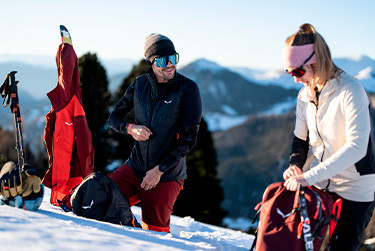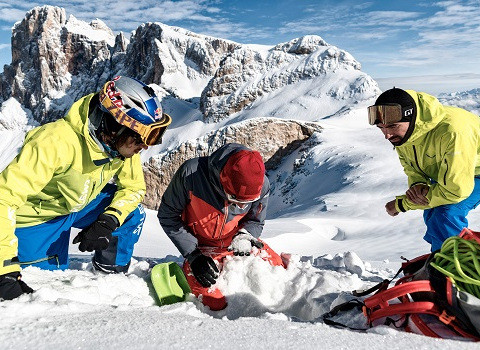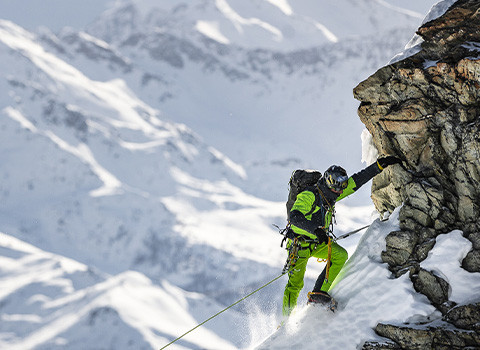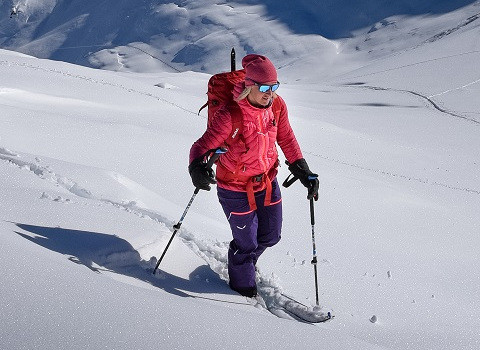expert advice / ski touring
HOW TO LAYER FOR
SKI TOURING
Ski mountaineering is an intense activity. Moving through the mountains in winter means that you need to take everything that you need with you. As such, every gram matters and unnecessary items are just extra weight to carry. Think lightweight, but durable. Quality counts too, trust us. You don’t want to have to start repairing your gear at 3,000 metres.
On a typical day in the mountains, temperatures can vary hugely, from sub-zero dawn starts when your breath hangs in the air, to hot sunny afternoons on open glaciers – with snowfall, strong winds and even sleet and rain all thrown into the mix.
Getting your clothing system right makes a massive difference. You want it to be versatile and adaptable enough to keep you warm in the coldest conditions but also breathable enough when skinning or working hard.
Layering is the key to dialling what you wear. This proven strategy lets you regulate your comfort by adding or peeling off layers according to activity levels and weather conditions.
Here’s a quick initial checklist of what to wear ski mountaineering:
- Long underwear
- Baselayer top
- Midlayer or softshell
- Ski socks
- Weather protection shell
- Extra insulation if you need it
- Alpine pant
- Gloves and spare gloves
- Helmet
- Hat and neck gaiter or balaclava
- Sunglasses/ goggles
- Don’t forget the avalanche rescue kit in your backpack
1. How to get your layers right
Unlike our earliest ancestors, we have no fur. We lost ours along the way during evolution, in order to help us sweat and dump heat while running long distances. So, when we head outdoors in winter, layering becomes part of our smart-technology thermostat.
To understand how to layer your clothing for ski mountaineering activities, you need to know the function of each layer and how they work together:
- Baselayer: wicks sweat away from your skin to keep you as dry as possible
- Midlayer (insulation): retains as much body heat as possible to keep you warm
- Outer layer (shell): protects you from wind, rain and snow
2. Next-to-skin: What are the best functional baselayers for ski mountaineering?
As the next-to-skin layer, a baselayer’s job is moving perspiration away from your skin, by “wicking.” Sweat is absorbed from the body and then quickly transported away through the fabric and the other layers into the atmosphere. In cool or cold conditions, wicking long-underwear-style base layers are needed to keep your skin dry. This is important because it helps to keep you from becoming chilled – or even worse hypothermic. Choose a functional fabric, such as wool, synthetic or silk (not cotton).
2.1 Wool or synthetic?
Wool fibres absorb up to 35% of their own weight in water, while synthetic fibres (usually polyester) only absorb up to 15%. This is why wool still feels dry even when you sweat. Although synthetic fibres absorb less sweat, they specialise in moving moisture away from the body faster. Bear in mind: it’s no urban myth that wool is highly (naturally) resistant to odour-causing bacteria. There are also some interesting hybrid solutions out there.
2.2. Lightweight or midweight baselayers?
This kind of depends on the temperatures and how much you feel the cold. For touring and other high-octane activities, the lightest option is usually fine, unless it's extremely cold. If you expect to be hanging about at cold belays, go for the warmer option. Don’t forget, moisture management also involves a certain amount of heat exchange or thermoregulation. So, the thinner a fabric is, the more small gaps there will be, and the more moisture vapour that can escape and cooling air that can enter. Meanwhile, thicker baselayers trap air (body warmth) near to the skin and provide more insulation.
Bear in mind though, in order for your baselayers to do their job properly, your whole layering system needs to work. Otherwise, the moisture drawn away from your skin will just be trapped there.
2.3. What kind of baselayers to wear on your legs
You want a winter wicking baselayer legging that fits well, stretches well and remains comfortable all day long. Your long johns need to move with you and work underneath your alpine pant and support the venting when you’re skinning or cranking hard. Also, don’t forget to wear good quality (wicking) underwear too. Three-quarter-length baselayer bottoms are worth a thought: the boot-cut won’t overlap your ski socks at the calves, where they can chafe and become uncomfortable when you’re trying to shred.
2.4. Which baselayer tops are best?
Remember, your next-to-skin layer’s primary function is moisture management. It’s your insulating midlayer that’s detailed to retain your body heat (not your baselayer). To be able to wick sweat efficiently, your baselayer needs to actually be next to your skin. Look for a comfortable, snug fit.
2.5. Baselayers – What kind of socks?
Socks are often the last thing people think about when gearing up for ski mountaineering. But there’s nothing more miserable than skiing or climbing with cold feet. Obviously, boot fit is crucial too, but many experts recommend choosing new boots together with the socks you intend to wear in them – for good reason.
We recommend using a good quality men’s or women’s ski sock with a high wool content. They don’t need to be too thick (in ski boots, the thermal liner provides the insulation). Make sure your socks fit snugly, but without being constricting, i.e. with wiggle room for your toes. If the fit is too tight, it can restrict circulation. Most mountain ski socks go up to the knee to help protect the shins.
Liner socks used to be popular for moisture-wicking ability to keep feet dry. Nowadays though, most mountain socks perform well enough to not require a liner sock. When comparing socks, the main differences you’ll notice are fabric composition and level of cushioning.
3. What midlayer is best for ski mountaineering?
People often obsess about shells and baselayers, but a warm, breathable midlayer is also essential to help you retain the heat radiated by your body.
The more efficiently it can trap heat, the warmer you’ll be. And the more breathable it is, the less you’ll have to worry about having to mess with your layers.
Your best options for midlayers are:
- Fleece
- Down insulated
- Synthetic
- Wool
- Softshell
3.1. Fleece
A lightweight or midweight fleece is a versatile insulation solution. Fleece will keep you warm even if it gets damp, and it dries fast too. Fleece also breathes well, so you’re less likely to overheat in it. The flipside of fleece, though, is that the wind often blows right through it. So, it only works in bad conditions when combined with a shell, unless you go for a version with a windproof membrane, such as Gore® Windstopper®. There are also some more sophisticated fleece fabrics out there, such as Polartec® Alpha® active insulation.
3.2. Down
Down is a nature’s natural midlayer and offers more warmth for its weight than any other insulating material. Down insulation is not made from feathers, but plumage – the soft, fluffy lofting underneath the feathers. Down is incredibly breathable and can wick unwanted moisture away fast to evaporate. And because down is always padded inside a shell material, down layers also offer some water and wind resistance. The drawback to down is that once damp, it loses pretty much most of its insulating properties and is slow to dry.
3.3. Synthetic insulation
Synthetic insulation is designed to mimic the qualities of down, but keep them even when wet. Its ultra-fine polyester fibres trap warmth in air pockets to maintain warmth. Synthetic insulation does have a lower warmth-to-weight ratio than down, which means that it needs to be heavier to achieve the same level of warmth. The big pro for synthetic insulation is that it’s resistant to moisture, and if it does get wet, it dries fast – especially in the sun or wind. This makes it a popular option for damper conditions. Naturally, you’ll find specific versions for men and women.
3.4. Wool
Alpine Wool and wool blends are another good midlayer option. Merino wool and wool from alpine sheep have outstanding thermal properties and excellent climate control. Wool fibres have a naturally crimped, wavy structure that traps air in the gaps between them to keep you warm. Wool is also easier to care for than down and also helps inhibit odour – so you can get by with fewer items of clothing, especially useful for multi-day trips in the mountains. Some manufacturers enhance the natural properties of wool with synthetic yarns to get the best of both worlds.
3.5. Softshell
There will be days when you are better off wearing just a softshell straight on top of your base layer for everything up to full storm conditions. These are the days when waterproofing can come secondary to breathability. The great thing about men’s and women’s softshells is that you get all-round performance from a single layer that you could wear for most of the day, reducing weight and bulk. Most important of all, you get greater comfort as you can control your microclimate better – a single layer is easier to adjust to stay warm or cool than multiple layers.
3.6. Top tip – pack a gilet
Call them what you will – bodywarmers, gilets or padded vests – they make an excellent, lightweight, compressible layer that will disappear in your pack. They are very effective at preserving heat around your core on cold-weather days, while leaving your arms with a full range of movement. On a warmer day, a good men’s or women’s gilet combined with an effective outer shell, might even mean you can do without an insulation jacket at all.
4. Choosing the right outer layer for ski mountaineering
Your outer layer (or shell layer) is there to protect you from wind, rain and snow. The waterproof rating of the fabric is measured using a water column or hydrostatic pressure test. The results are generally given in millimetres (mm). The higher the water column rating, the greater the water pressure a material can withstand, and the greater the level of waterproofness.
You should almost be a little cold when you set out, as things will warm up with movement. Thankfully, these days most shells for women and men are breathable to a certain extent and allow perspiration to escape so you don’t get soaked from the inside out. Breathability is measured by testing the Moisture vapour transmission Rate (MVTR), and is shown as g/m²/24h. This shows how much moisture vapour will pass through a square metre of fabric in a 24-hour period (g/m2/24). The greater the MTVR, the greater the moisture vapour transmission rate, and the better the breathability.
4.1. Do you need a fully waterproof hardshell or will a water-resistant shell do the job?
Your shell is only as effective as the layers you choose to use underneath it. The better your baselayer, the less your hardshell has to do. Breathable and lightweight layers are sometimes the better option and can make all the difference on long uphill slogs in the backcountry.
Pay attention to the conditions; on some days you might not need that big hardshell, especially if you are moving fast and there’s just mist or drizzle. A simple shell with a durable water repellent (DWR) finish might be all that’s required. However, if a big dump is forecast, then pack that big badass storm defence hardshell to pull on over everything, because if wind and water get into your inner layers, you can get seriously chilled.
4.2. Consider a softshell
Softshells are your do-it-all action layer that should provide enough insulation to stay warm when active in cold conditions, but be breathable enough for warmer conditions or high aerobic activity. They should give a high degree of water resistance and windproofing to keep wet snow and showers out and to maintain your microclimate in bad weather.
Modern men’s and women’s softshells offer more performance for weight than a plain fleece and windproof layer. Go for one with a hood, as this reduces your reliance on your waterproof and increases your weather protection without adding much weight.
4.3. Insulated outer layers for super cold conditions
There will be days when conditions are so cold that your midlayer alone won’t cut it. Bring out your insulated jacket. Thanks to women specific cuts they fit female users much better these days. The conditions and activity level will determine the type of insulation and how warm you want to go.
Having said that, a big jacket is a definite no-go for high-exertion activity. This is the jacket you belay in (or even bivvy in) on snowy ledges, throw on when you’re hanging about on really cold days and is your extra emergency layer against the cold. It could be a light down or a synthetic fill jacket, which might be more effective in stormy conditions. Don’t be tempted to lug up a monster jacket ‘just in case’; you know you’ll only regret having its dead weight bulking out your pack most of the time.
Look after your outer layers
If you feel that your weather protection gear is letting you down, there’s no need to run out and buy a new jacket. Try cleaning yours with a tech cleaner and refreshing the DWR (Durable Water Repellent) finish to get a lot more life out of it.
4.4. What to wear on your legs for ski mountaineering
Your legs need less insulation. They’re mainly made of muscle and bone and it’s surprising what temperatures you can get by in with just a thin alpine pant (with or sometimes even without a baselayer). Your alpine pant needs to be lightweight, water resistant (DWR), windproof, wicking, quick drying and tough and flexible enough to ski and climb in. Ideally, it should also allow plenty of ventilation, and have a closer, more contoured fit.
Softshell fabrics are ideal for alpine pants. Backcountry-specific models might be less weather-resistant, but you get greater breathability for skinning uphill, less weight, and a greater range of motion. Women’s versions tend to be slightly warmer than men’s versions. Alpine pants are pretty robust and can last a lifetime, especially if they have reinforced kick patches to protect against ski edges and crampon snags.
Other features to consider include: Do you want a velcro-adjustable waist? Do you prefer to use your pants with braces/suspenders or an integrated belt? And make sure your pants still fit well over your ski boots.
Get some gaiters
Mountaineering gaiters provide heavy-duty protection for ice climbing and backcountry skiing and add some insulation for extended trips in deep snow and harsh conditions. Go for a tough, waterproof and breathable fabric and a trim, close fit. Big boots, such as mountaineering boots or ski boots, may require you to size up. Front closure is a good idea, as it allows you to adjust your laces/buckles without having to take them off.
5. Further tips for ski mountaineering
5.1. Hats
Pack a hat or headband and a neck gaiter or neck tube. If you’re expecting stormy weather, a balaclava might be a better option as it does the work of both hat and neck gaiter and protects the whole of your face. You’ll find plenty of different styles for men and women.
5.2. Helmets
Invest in a good helmet. Alternatively, rent or borrow one. Brighter colours are better for alpine use, but avoid dark, heat-absorbing colours. Wear it until you’re well out of danger. Shelled foam helmets are great for alpine use as they are lighter than rigid helmets. Rigid helmets provide more protection but are slightly heavier. The choice is yours. Whatever you go for, make sure your helmet fits a head torch. To get a snug fit: place the helmet firmly on your head and before you close the chin strap, shake your head from side to side and tilt it back, then adjust and close the chin strap.
5.3. Get some good gloves
Gloves might be the best example of ‘buy the best you can afford’… Leather-palmed softshell gloves in women’s and men’s specific designs now pretty much set the benchmark for alpine gloves. Plain leather gloves also work well and are worth experimenting with. They can also be backed up with an inexpensive liner. Don’t forget to take spare gloves and a thin, performance fleece glove that remains warm when wet for the walk-in, back at camp, etc. You might want to pack some hand cream too. Your friends will thank you when they see the state of their own skin.
5.4. Handwarmers
Handwarmers are a bit of an emergency godsend to provide hours of heat even when your gloves are wet and cold. Don’t forget though, there’s still no guaranteed way of escaping the screaming barfies or hot aches.
5.5. Goggles
Important to protect your eyes from wind, snow and glare. Check that they work with your helmet. If you don’t own any, maybe you can borrow some from a friend. If it’s not actually snowing, blowing a gale or foggy/flat light, sunglasses also work well too.
5.6. Sunscreen
Yes, you still need sunscreen in winter. Buy the highest factor you can and don’t forget to use it. Pick a small size that will fit in your pack and don’t forget your lips.
5.7. Use what you’ve got
If your gear lacks some specific features found on ski mountaineering specific pieces, save by using what you already own. Ski mountaineering is about getting out there, not obsessing about gear. Just make sure what you do have, works for you. Buy the best you can afford. Even if you can’t quite stretch to everything on your wishlist, then view being under-equipped as part of the challenge.
Related Topics
AVALANCHE SAFETY: ALL YOU NEED TO KNOW
The best defence against avalanches is to learn how avalanches work and how to avoid them.
HOW TO PREVENT ALTITUDE SICKNESS
that is triggered by ascending to high altitudes without allowing your body the time to adjust, or acclimatize, as it’s known.
HOW TO GET INTO SKI TOURING
Ski touring makes use of special adapted touring skis and touring bindings that convert from free-heel to fixed-heel mode.





